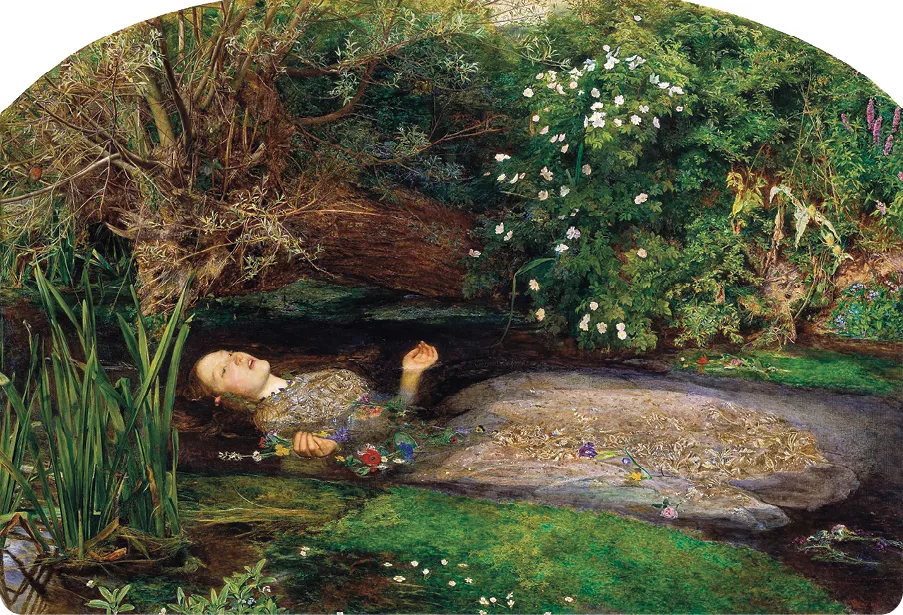Unit 2
Activity 2
The new face of beauty
Ressource affichée de l'autre côté.
Faites défiler pour voir la suite.
Faites défiler pour voir la suite.
Texte
The new face of beauty
Two-and-a-half centuries after William Shakespeare's
Hamlet came to the stage, the tragic-romantic figure
of Ophelia reignited the Victorian imagination in
paintings, poetry, and plays. Among the era's many
Ophelias, none proved so indelible as Pre-Raphaelite
painter John Everett Millais's richly detailed rendering
of the tragic heroine drowning. Now in the collection
of the Tate, Ophelia (1851-1852) is one of the defining
images of the Pre-Raphaelite movement. [...]
While it may be difficult to see today, when Millais debuted Ophelia in 1852, it scandalized critics. Pre-Raphaelite depictions of their models (often their wives, lovers, and sisters) dismayed the conventions of Victorian good taste. “The open mouth is somewhat gaping and babyish...,” wrote one critic. [...]
The English painter Joshua Reynolds had emphasized that the artist should attempt to idealize nature – including in depictions of female beauty. The Pre-Raphaelites, instead, chose unconventional looking women with heavy mantles of hair, hooded eyes, and full lips as their models. These women's bold looks disturbed Victorian viewers whose norms of beauty and grace emphasized the delicate and the demure. Nevertheless, by the 1870s, the very features had become widely admired in artistic circles. [...] Within just 20 years, the artists had expanded the understanding of beauty.
While it may be difficult to see today, when Millais debuted Ophelia in 1852, it scandalized critics. Pre-Raphaelite depictions of their models (often their wives, lovers, and sisters) dismayed the conventions of Victorian good taste. “The open mouth is somewhat gaping and babyish...,” wrote one critic. [...]
The English painter Joshua Reynolds had emphasized that the artist should attempt to idealize nature – including in depictions of female beauty. The Pre-Raphaelites, instead, chose unconventional looking women with heavy mantles of hair, hooded eyes, and full lips as their models. These women's bold looks disturbed Victorian viewers whose norms of beauty and grace emphasized the delicate and the demure. Nevertheless, by the 1870s, the very features had become widely admired in artistic circles. [...] Within just 20 years, the artists had expanded the understanding of beauty.
Ressource affichée de l'autre côté.
Faites défiler pour voir la suite.
Faites défiler pour voir la suite.


John Everett Millais, Ophelia, 1851-1852.
Ressource affichée de l'autre côté.
Faites défiler pour voir la suite.
Faites défiler pour voir la suite.
The Pre-Raphaelites /ˌpriːˈræfəlaɪt/ were a group of British artists formed
in 1848. They rejected the academic art style influenced by the Renaissance
painter Raphael and his idealized compositions. Instead, they focused on
realism. Their work often drew on classic literature.
Ressource affichée de l'autre côté.
Faites défiler pour voir la suite.
Faites défiler pour voir la suite.
Path A
A2+
1-A
Who is the character represented in the
painting? Pick out information about her.
2-A
Note down words describing the appearance
of the women painted by Millais and the Pre-Raphaelites. Are they positive or negative?
3-A
Find the sentence showing the influence
of the Pre-Raphaelite movement on beauty.
Ressource affichée de l'autre côté.
Faites défiler pour voir la suite.
Faites défiler pour voir la suite.
Path B
B1+
1-B
Pick out information about the painter
and the movement he was a part of.
What did their paintings focus on?
2-B
How did the painter Joshua Reynolds and critics
react to the painting in 1852? And in 1870?
3-B
What elements of modernity can you find
in this painting?
Ressource affichée de l'autre côté.
Faites défiler pour voir la suite.
Faites défiler pour voir la suite.
Let's talk this out!
4
What was new at the time about the way women were represented in Pre-Raphaelite art?
5
How have people's reactions to it changed over time? What does this show about beauty standards?
Ressource affichée de l'autre côté.
Faites défiler pour voir la suite.
Faites défiler pour voir la suite.
Over to you!
Write the voice-over of an exhibit trailer.
You are part of the creative team for the museum's new exhibit. Your task is to write the introduction for the exhibit's promotional video. The voice-over must be captivating, concise, and reflect how beauty standards have evolved across time.
You are part of the creative team for the museum's new exhibit. Your task is to write the introduction for the exhibit's promotional video. The voice-over must be captivating, concise, and reflect how beauty standards have evolved across time.
Cliquez pour accéder à un module d'enregistrement audio
Enregistreur audio
Une erreur sur la page ? Une idée à proposer ?
Nos manuels sont collaboratifs, n'hésitez pas à nous en faire part.
j'ai une idée !
Oups, une coquille
